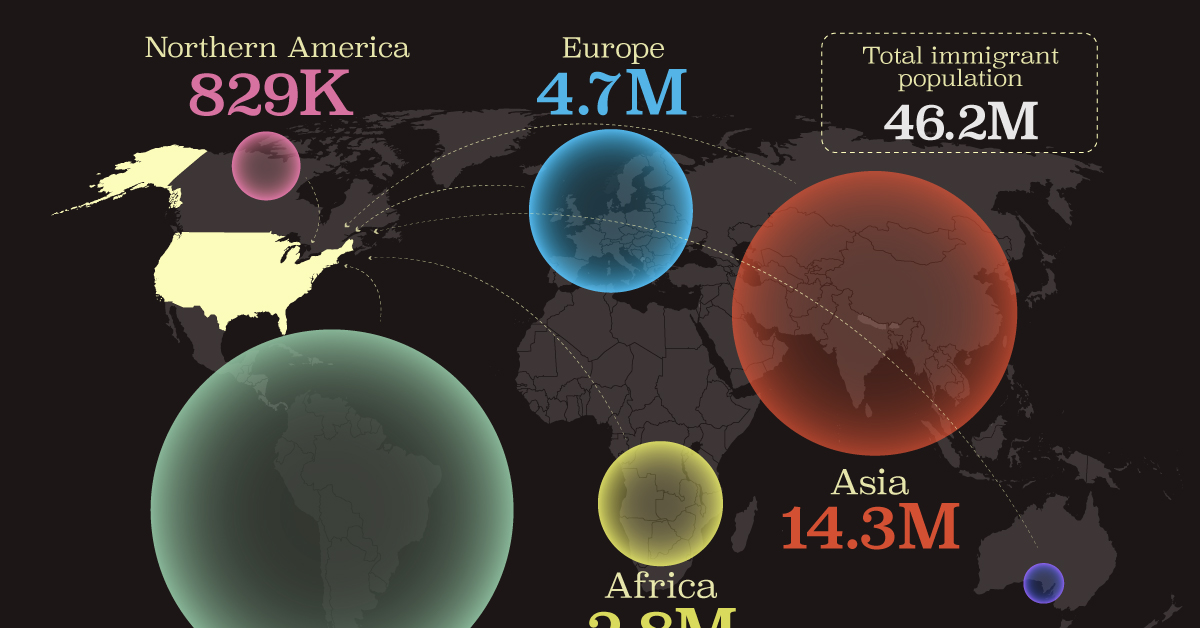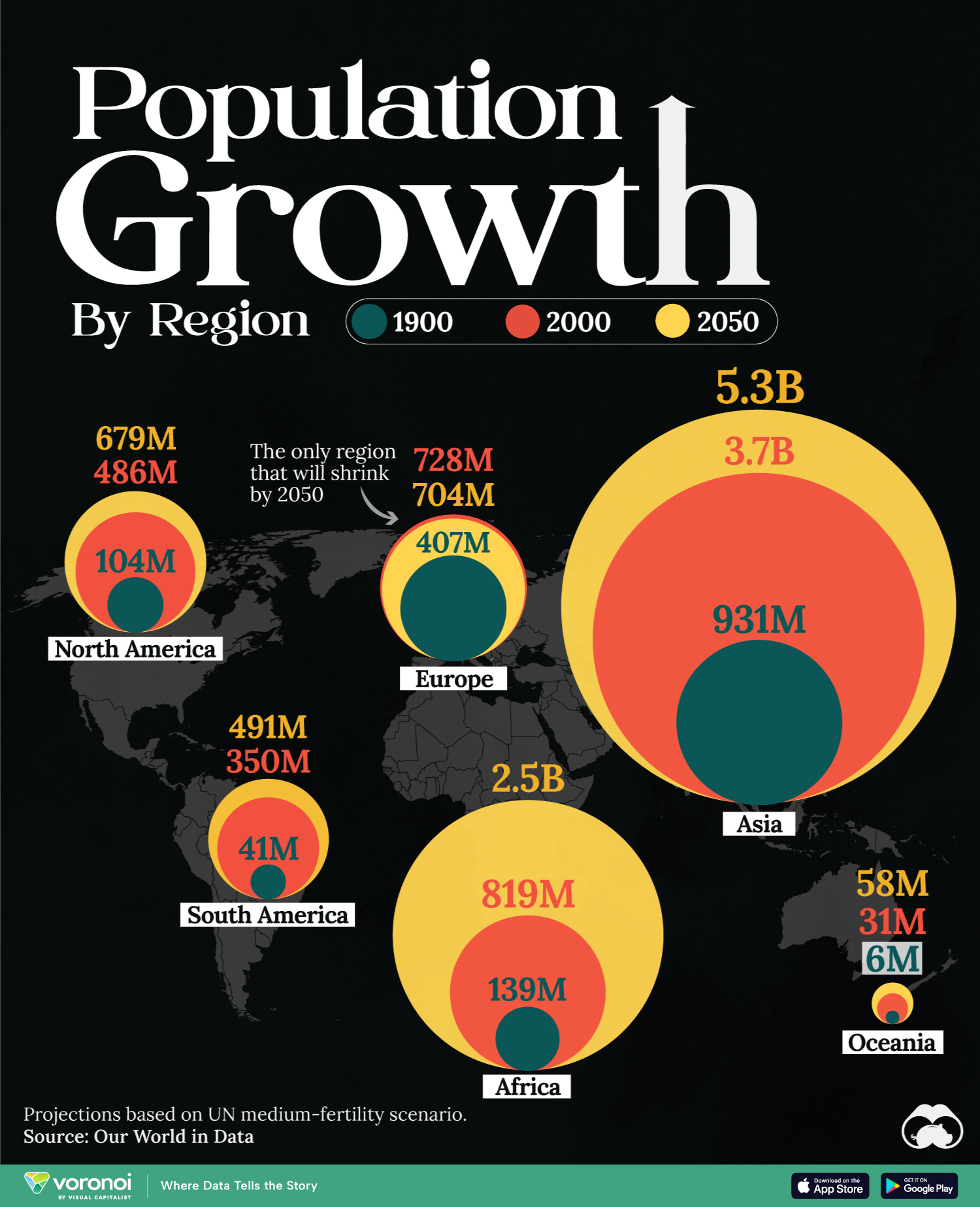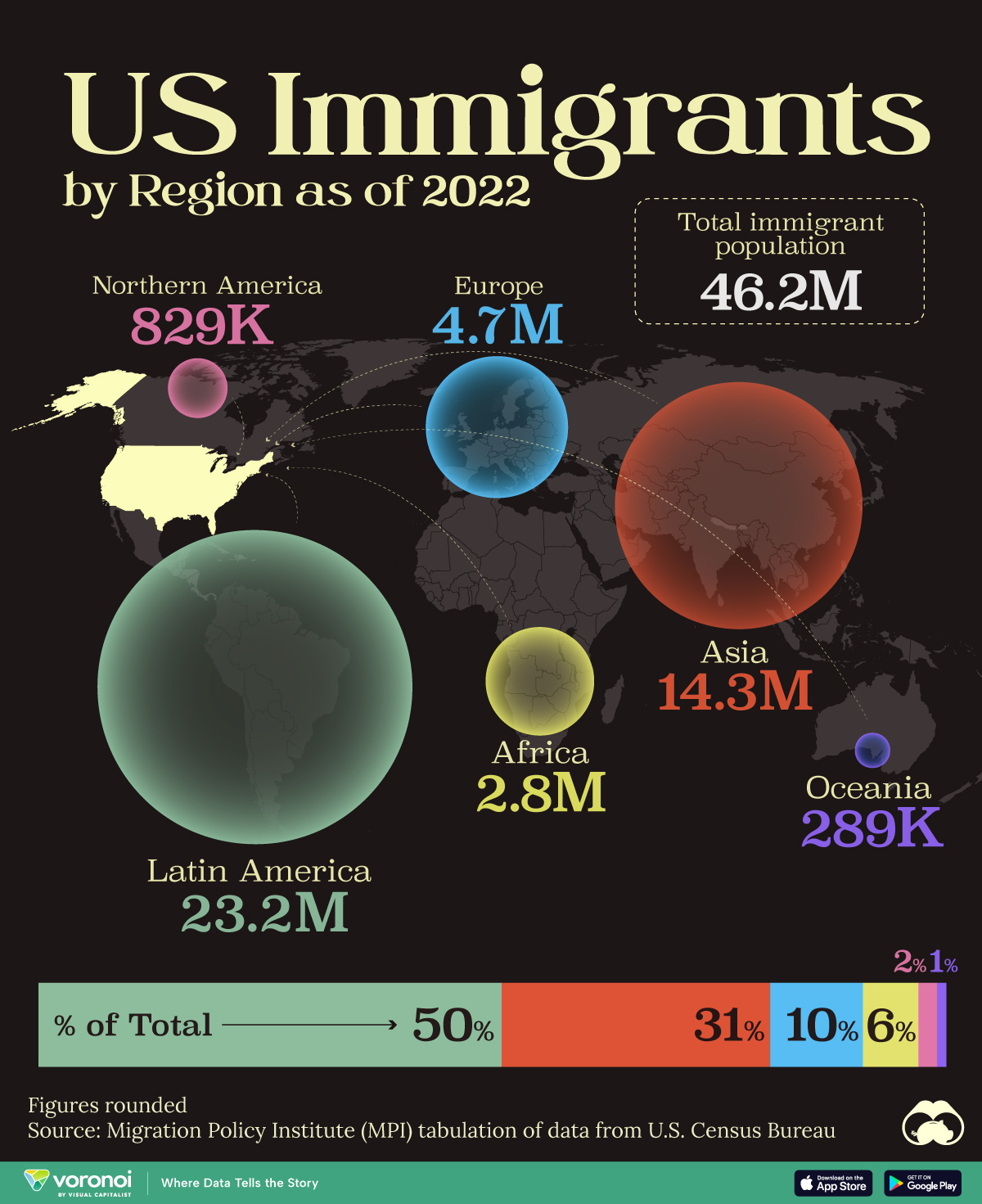Maps
Mapped: Population Growth by Region (1900-2050F)
![]() See this visualization first on the Voronoi app.
See this visualization first on the Voronoi app.
Mapping Population Growth by Region
This was originally posted on our Voronoi app. Download the app for free on iOS or Android and discover incredible data-driven charts from a variety of trusted sources.
In fewer than 50 years, the world population has doubled in size, jumping from 4 to 8 billion.
In this visualization, we map the populations of major regions at three different points in time: 1900, 2000, and 2050 (forecasted). Figures come from Our World in Data as of March 2023, using the United Nations medium-fertility scenario.
Population by Continent (1900-2050F)
Asia was the biggest driver of global population growth over the course of the 20th century. In fact, the continent’s population grew by 2.8 billion people from 1900 to 2000, compared to just 680 million from the second on our list, Africa.
| Region | 1900 | 2000 | 2050F |
|---|---|---|---|
| Asia | 931,021,418 | 3,735,089,775 | 5,291,555,919 |
| Africa | 138,752,199 | 818,952,374 | 2,485,135,689 |
| Europe | 406,610,221 | 727,917,165 | 704,398,730 |
| North America | 104,231,973 | 486,364,446 | 679,488,449 |
| South America | 41,330,704 | 349,634,344 | 491,078,697 |
| Oceania | 5,936,615 | 31,223,133 | 57,834,753 |
| World 🌐 | 1,627,883,130 | 6,149,181,237 | 9,709,492,237 |
China was the main source of Asia’s population expansion, though its population growth has slowed in recent years. That’s why in 2023, India surpassed China to become the world’s most populous country.
Southeast Asian countries like the Philippines and Indonesia have also been big drivers of Asia’s population boom to this point.
The Future: Africa to Hit 2.5 Billion by 2050
Under the UN’s medium-fertility scenario (all countries converge at a birthrate of 1.85 children per woman by 2050), Africa will solidify its place as the world’s second most populous region.
Three countries—Nigeria, Ethiopia, and Egypt—will account for roughly 30% of that 2.5 billion population figure.
Meanwhile, both North America and South America are expected to see a slowdown in population growth, while Europe is the only region that will shrink by 2050.
A century ago, Europe’s population was close to 30% of the world total. Today, that figure stands at less than 10%.
Demographics
Mapped: U.S. Immigrants by Region
This map shows which regions U.S. immigrants came from, highlighting Asia and Latin America as the biggest sources.

Breaking Down America’s Immigrant Population
This was originally posted on our Voronoi app. Download the app for free on iOS or Android and discover incredible data-driven charts from a variety of trusted sources.
The United States is home to more immigrants than any other nation, surpassing the combined totals of the next four countries: Germany, Saudi Arabia, Russia, and the United Kingdom.
To add context to this impressive fact, we’ve illustrated the regions from which U.S. immigrants originated. “Immigrants” in this context refers to individuals who are residing in the United States but were not U.S. citizens at birth.
These statistics were sourced from the Migration Policy Institute, which analyzed data from the U.S. Census Bureau’s 2022 American Community Survey (ACS).
U.S. Immigrants by Region
From this graphic, we can see that Asia and Latin America emerge as the primary sources of immigration, collectively accounting for 81% of America’s 46.2 million immigrants.
| Region | # of Immigrants | % of Total |
|---|---|---|
| Europe | 4,728,948 | 10 |
| Asia | 14,349,080 | 31 |
| Africa | 2,752,965 | 6 |
| Oceania | 288,560 | 1 |
| Northern America | 828,702 | 2 |
| Latin America | 23,233,834 | 50 |
| Total | 46,182,089 | 100 |
Latin America alone contributes half of the immigrant population. Mexico stands out as the largest contributor to U.S. immigration, with 10.7 million immigrants, attributable to its geographical proximity and historical ties.
Economic factors, including wage disparity and employment opportunities, drive many Mexicans to seek better prospects north of the border.
From Asia, the two largest country sources are China (2.2 million) and India (2.8 million).
Learn More About U.S. Immigration From Visual Capitalist
If you enjoyed this post, be sure to check out Why Do People Immigrate to the U.S.? This visualization shows the different reasons why immigrants chose to come to America in 2021.
-

 Energy4 days ago
Energy4 days agoWho’s Building the Most Solar Energy?
-

 Wealth2 weeks ago
Wealth2 weeks agoCharted: Which Country Has the Most Billionaires in 2024?
-

 Markets2 weeks ago
Markets2 weeks agoThe Top Private Equity Firms by Country
-

 Jobs1 week ago
Jobs1 week agoThe Best U.S. Companies to Work for According to LinkedIn
-

 Economy1 week ago
Economy1 week agoRanked: The Top 20 Countries in Debt to China
-

 Misc1 week ago
Misc1 week agoCharted: Trust in Government Institutions by G7 Countries
-

 Energy1 week ago
Energy1 week agoMapped: The Age of Energy Projects in Interconnection Queues, by State
-

 Mining1 week ago
Mining1 week agoVisualizing Global Gold Production in 2023















